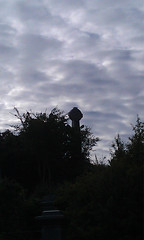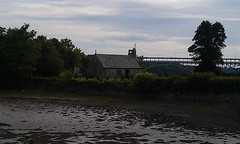As a birthday surprise, my Angel (who is truly deserving of that term) whisked me off to North Wales for a couple of nights, so that we could visit Neolithic and Celtic sites. Anglesey is an island (well, acutally two islands) just off the north-west coast of Wales. It's an absolute treasure trove of ancient Celtic and pre-Celtic burial and sacred sites, so much so that the smaller island is called 'holy island'. As with all Celtic stuff, it's very hard to know exactly who worshipped at these places. With some, though, local folklore suggests folk memories of relatively recent worship at the sites.





There was evidence of a recent Pagan ritual here - flowers had been left on the goddess figure and there were the remains of a candle in a corner, and the signs of the goddess and the god had been drawn in chalk on one of the wooden supporting beams. I saw flowers left at all the sites I visited (from recent Litha rites, maybe?) - it was awesome to feel like I was joining a hidden community of worshippers in my pilgrimage. Of all the sites we went to, Bryn Celli Ddu felt the most sacred. I'm just learning to feel energy, but I could really feel it here. There had been a lot of worship at that site, over many centuries. It was amazing. I stayed until the Angel reminded me we had an entire day's worth of sites to see!
The next site we tried to visit was inaccessible to me. This was the case with about half of the sites. The problem was mostly not the natural landscape, but the 'kissing gates' that Welsh Heritage have put in around these sites, to keep out animals. There are wheelchair-friendly versions of these gates available, and I might write to WH and ask them to consider putting these in! On the way to the next site, though, we passed a random field full of standing stones, and went to investigate. They'd all been laid out in a line, across land that has now been divided into two fields. We wondered about what they'd been put there to represent, in the beginning. The straight line suggested they were some kind of marker of direction, but they could also have had a more spiritual purpose. The sheep didn't seem to mind us being there too much.
Next was the Presaddfed burial chambers, a set of two Neolithic tombs, although one has collapsed. They would have involved some fairly serious engineering. Impressive stuff. We then went on to Din Lligwy. This was my favourite of them all. There are three sites here - a fort dating back at least to Roman times, another excavated burial mound, and a twelfth-century church. I completely *loved* the church. My photo of the outside of it has been garbled by my phone, so here's one I've borrowed from a website:
I don't know exactly what it was about this church, but it felt older than twelfth century. I'd like to know if the circle of stones around it is older than that (the online guides don't say). Regardless, you can certainly tell that years of worship has taken place there. It's beautiful. As is the view of the bay from just behind it:

Just a few metres' walk from the church is the Celtic settlement dating back to 4BC, with parts of it possibly much older. According to the information provided there, the inhabitants would have been well protected from the Romans within the settlement. It was fascinating. Tiny round huts and a bigger workshop. It's thought that the community farmed the surrounding area.

The burial cromlech at the same site, a few minutes' drive away from the settlement, was wonderful. It looked much the same as many of the others we saw - low and squat, with a main stone supported by several smaller ones. It felt different, though. It was close to the road, so I left the Angel in the car and went in alone. But because it was surrounded by a fence, which you enter through a gate, it felt very secluded. I was the only person there for about twenty minutes, which meant I could do a little ritual - which made me feel incredibly lucky, and part of something.
Some flowers had been left on the main stone - again the link to community. It's a weird and mysterious thing, this 'hidden community' thing, after the 'ridiculously over-visible community' thing of my Christian tradition. I like how Pagans are, in one way or another, continuing traditions that have been going on at these places for up to 4000 years. But quietly.
Those were the main sites we were planning to attempt, apart from random standing stones around the island, and a church on its own little island (helpfully called Church Island!) On our way home, though, we noticed another one marked on the map. This one was another burial cromlech, set in the grounds of a country place. It was an odd place, again with evidence of rituals having been done there, but not in a way that I particularly approved of! (Along with ritual items being left there, paint in various colours had been applied to the underside of the main stone. That can't be respectful.) It was fascinating, though. I can totally see why the ancients and Celts saw these cromlechs as gateways to the world of the dead or the Otherworld. They're just amazing places.

 I've had some fairly interesting experiences (during and) since this little trip. I'm still pondering them. Recently I've been feeling bad about how fast I seem to be moving into what is basically a new framework for old beliefs (I suppose I don't want to be labelled a 'fluffy bunny' - heh - but I also know how very, very, VERY much there is to learn, and it's overwhelming and scary and challenging all at the same time). I'm a long way from settling on certain practices, making final choices over the gods I'm going to worship, or even choosing specific labels for myself - but I'm also learning what people mean when they say that they've been something all their life. Clearly, I have not been a Pagan all my life - I've been a Christian, specifically a strongly Gnosticism-influenced one for the past ten years or so. On the other hand, I am not new to the Divine or to esoteric beliefs and practices - my practices for the past ten years have been remarkably similar to much of what I'm exploring at the moment. And yet, this is also all very new. I'm stuck between being terrified to do anything because I feel so new and lost, and also devouring everything I can because it's all so oddly familiar and makes complete sense. It's paradoxical.
I've had some fairly interesting experiences (during and) since this little trip. I'm still pondering them. Recently I've been feeling bad about how fast I seem to be moving into what is basically a new framework for old beliefs (I suppose I don't want to be labelled a 'fluffy bunny' - heh - but I also know how very, very, VERY much there is to learn, and it's overwhelming and scary and challenging all at the same time). I'm a long way from settling on certain practices, making final choices over the gods I'm going to worship, or even choosing specific labels for myself - but I'm also learning what people mean when they say that they've been something all their life. Clearly, I have not been a Pagan all my life - I've been a Christian, specifically a strongly Gnosticism-influenced one for the past ten years or so. On the other hand, I am not new to the Divine or to esoteric beliefs and practices - my practices for the past ten years have been remarkably similar to much of what I'm exploring at the moment. And yet, this is also all very new. I'm stuck between being terrified to do anything because I feel so new and lost, and also devouring everything I can because it's all so oddly familiar and makes complete sense. It's paradoxical.But then, the Celts do like those paradoxes. When it comes to Celtic-influenced beliefs, I know these gods. I've known many of their legends for a long time, and I know the land they shaped. My mother's family come from the place where the legends of Cailleach Beara (sometimes thought of as the dark face of Brigit) emerged - the incredibly beautiful Beara Peninsula in County Cork, Ireland. My father's family come, for as many generations as they can remember, from the country where I was enjoying these neolithic sites this past weekend. My deepest spiritual experiences have been particularly associated with the land of my maternal ancestors, although I didn't always know what that meant. But I'm beginning to. Anyway. Much thinking and writing to be done. Always with the work to do! I should perhaps not forget I've got two conference presentations to write over the next two weeks. Heh.


Interesting! Thank you for posting this. One day, I will visit the UK, and see these beautiful sacred sites. I thoroughly enjoyed your discussion with Fire Lyte on the "Inciting a Riot" podcast! I must admit that, though I was born with cerebral palsy, and walk around on four wheels just like yourself, I never thought too deeply about society creating the disability, as opposed to the individual having a physical/mental disability. I largely agree with you.
ReplyDeleteBlessings to you on your spiritual journey. Don't feel badly about using a new framework for old beliefs. Despite the complaints you'll get from "Reconstructionists", the truth is, we don't know too much about the ritual practices of the Norse, the Celts, ancient Egyptians, etc.
I was not brought up a Christian (rare, I know), but have felt since my teenage years that the Divine has many names and faces. I only began using the term Pagan to describe my path a few years ago, but I can truly say that I have always been Pagan. As for yourself, I wouldn't be surprised if you choose to define yourself as a Christo-Pagan in the future. Despite the complaints you'll get from some Christians (and Pagans!), there is nothing wrong with having Jesus as a God, and Mary as a Goddess!
Thanks for your thoughts! I'm really glad you enjoyed the podcast episode - I *loved* being interviewed for it. I'm such a huge Inciting A Riot fan!
ReplyDeleteWhen I say I'm using a new framework for old beliefs, I perhaps had it the wrong way around :) What I meant was that old-for-me beliefs are fitting into new-to-me frameworks, along Pagan lines, and it's both wonderful and slightly uncomfortable. But it's mostly wonderful. You're right, there's nothing contradictory about Christo-Paganism, and it's definitely a possible path for me. Thanks for the interesting thoughts!